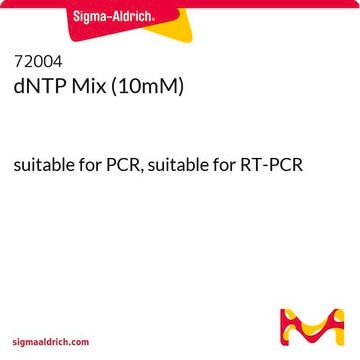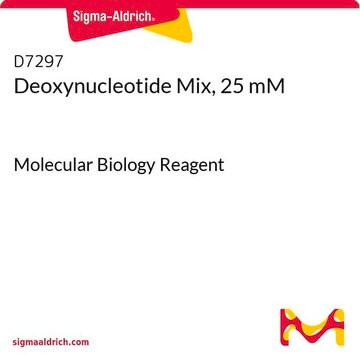DNTPCA1
CleanAmp™ dNTP
Hot-start dNTP mix for improved PCR
Synonyme(s) :
Deoxynucleotides, dNTP, dNTP Mix
About This Item
Produits recommandés
Forme
liquid
Caractéristiques
hotstart
Concentration
10 mM (each dNTP)
Couleur
colorless
Conditions d'expédition
dry ice
Température de stockage
−20°C
Vous recherchez des produits similaires ? Visite Guide de comparaison des produits
Description générale
Application
- For PCR amplifications that require reduced non-specific amplification
- For multiplex PCR
- For reduction of primer dimers
- Substitute for dNTPs in any PCR reaction
Conditionnement
10 μmoles: 1 vial, 1000 μL, each dNTP at 10 mM in 50 mM Glycine
Informations légales
Code de la classe de stockage
12 - Non Combustible Liquids
Classe de danger pour l'eau (WGK)
WGK 2
Point d'éclair (°F)
Not applicable
Point d'éclair (°C)
Not applicable
Certificats d'analyse (COA)
Recherchez un Certificats d'analyse (COA) en saisissant le numéro de lot du produit. Les numéros de lot figurent sur l'étiquette du produit après les mots "Lot" ou "Batch".
Déjà en possession de ce produit ?
Retrouvez la documentation relative aux produits que vous avez récemment achetés dans la Bibliothèque de documents.
Les clients ont également consulté
Articles
Identify causes and remedies for SDS-PAGE sample preparation challenges and optimize electrophoresis conditions.
Notre équipe de scientifiques dispose d'une expérience dans tous les secteurs de la recherche, notamment en sciences de la vie, science des matériaux, synthèse chimique, chromatographie, analyse et dans de nombreux autres domaines..
Contacter notre Service technique











